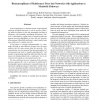Free Online Productivity Tools
i2Speak
i2Symbol
i2OCR
iTex2Img
iWeb2Print
iWeb2Shot
i2Type
iPdf2Split
iPdf2Merge
i2Bopomofo
i2Arabic
i2Style
i2Image
i2PDF
iLatex2Rtf
Sci2ools
128
click to vote
BIBE
2007
IEEE
2007
IEEE
Homomorphisms of Multisource Trees into Networks with Applications to Metabolic Pathways
Network mapping is a convenient tool for comparing and exploring biological networks; it can be used for predicting unknown pathways, fast and meaningful searching of databases, and potentially establishing evolutionary relations. Unfortunately, existing tools for mapping paths into general networks (PathBlast) or trees into tree networks allowing gaps (MetaPathwayHunter) cannot handle large query pathways or complex networks. In this paper we consider homomorphisms, i.e., mappings allowing to map different enzymes from the query pathway into the same enzyme from the networks. Homomorphisms are more general than homeomorphism (allowing gaps) and easier to handle algorithmically. Our dynamic programming algorithm efficiently finds the minimum cost homomorphism from a multisource tree to directed acyclic graphs as well as general networks. We have performed pairwise mapping of all pathways for four organisms (E. coli, S. cerevisiae, B. subtilis and T. thermophilus species) and found a...
| Added | 02 Jun 2010 |
| Updated | 02 Jun 2010 |
| Type | Conference |
| Year | 2007 |
| Where | BIBE |
| Authors | Qiong Cheng, Robert W. Harrison, Alexander Zelikovsky |
Comments (0)

